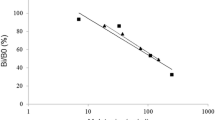Abstract
Administration of melatonin in the drinking water (200 μg/ml in 1% ethanol) decreased the time of re-entrainment of the circadian rhythm of the metabolic rate (measured as oxygen uptake) of domestic canaries (Serinus canaria) after 10-h delay phase shifts of the light-dark (LD) cycle by 1.3 days on average. Associated with faster re-entrainment, the amplitude of the metabolic rhythm was attenuated by 46% on, average on the first day after the shift as compared with about 25% in the controls. After re-entrainment, the amplitude of the metabolic rhythm during melatonin administration was about 23% lower than in the controls. The minimum resting metabolic rate increased by ca 5% on average during treatment with melatonin. The results are consistent with the hypothesis that constant high plasma levels of melatonin act on higher levels of the circadian oscillatory system rather than by directly affecting peripheral or central photoreceptors.
Similar content being viewed by others
References
Menaker, M., Takahashi, J. S., and Eskin, A., A. Rev. Physiol.40 (1978) 501.
Cassone, V. M., and Menaker, M., J. exp. Zool.232 (1984) 53.
Aschoff, J., and Wever, R., Z. vergl. Physiol.,46 (1963) 321.
Aschoff, J., Hoffmann, K., Pohl, H., and Wever, R., Chronobiologia2 (1975) 23.
Pohl, H., Intern. J. Chronobiology5 (1978) 493.
Hau, M., and Gwinner, E., Physiol. Behav.58 (1995) 89.
Murakami, N., Hayafuji, C., Sasaki, Y., Yamazaki, J., and Takahashi, K., Neuroendocrinology36 (1983) 385.
Arendt, J., Aldhous, M., and Marks, V., Br. med. J.292 (1986) 1170.
Redman, J. R., and Armstrong, S. M., J. Pineal Res.5 (1988) 203.
Illnerová, H., Trentini, G. P., and Maslova, L., J. comp. Physiol A166 (1989) 97.
Samel, A., Wegmann, H. M., Vejvoda, M., Maab, H., Gundel, A., and Schütz, M., J. Biol. Rhythms6 (1991) 235.
Golombek, D. A., and Cardinali, D. P., Chronobiol. Intern.10 (1993) 435.
Oakley, N. R., Interdiscipl Cycle Res.24 (1993) 294.
Pohl, H., J. Ornithol.112 (1971) 266.
Gänshirt, G., Daan, S., and Gerkema, M. P., J. comp. Physiol. A154 (1984) 669.
Pohl, H., Z. vergl. Physiol.66 (1970) 141.
Hendel, R. C., and Turek, F. W., Physiol. Behav.21 (1978) 275.
Gwinner, E., in: Circadian Clocks and Ecology, p. 127. Eds T. Hiroshige and K. I. Honma. Hokkaido Press, Sapporo 1994.
Pohl, H., Physiol. Zool.67 (1994) 723.
Gwinner, E., Hau, M., and Heigl, S., in: Evolution of Circadian Clock, p. 127. Eds T. Hiroshige and K. I. Honma. Hokkaido Press, Sapporo 1994.
Hau, M., and Gwinner, E., J. comp. Physiol. A175 (1994) 343.
Pittendrigh, C. S., in: Handbook of Behavioral Neurobiology. 4. Biological Rhythms, p. 57. Ed. J. Aschoff, Plenum Press, NY 1981.
Chesworth, M. J., Cassone, V. M., and Armstrong, S. M., Am. J. Physiol.253 (1987) R101.
Warren, W. S., and Cassone, V. M., J. biol. Rhythms10 (1995) 64.
Pohl, H., Federation Proceedings29 (1969) 1541.
Binkley, S., Kluth, E., and Menaker, M., Science174 (1971) 311.
John, T. M., and George, J. C., J. interdiscipl. Cycle Res.15 (1984) 57.
John, T. M., and George, J. C., in: Photobiology, p. 597. Ed. E. Riklis. Plenum Press, NY 1991.
Cassone, V. M., Warren, W. S., Brooks, D. S., and Lu, J., J. biol. Rhythms8, Suppl. (1993) 73.
Iuvone, P. M., Galli, C. L., Garrison-Gund, C. K., and Neff, N. H., Science202 (1978) 901.
Dubocovich, M., Nature306 (1983) 782.
Iuvone, P. M., and Gan, J. W., J. Neuroscience15 (1995) 2179.
Author information
Authors and Affiliations
Rights and permissions
About this article
Cite this article
Pohl, H. Exogenous melatonin accelerates re-entrainment: Attenuation of the circadian rhythm of metabolic rate in the canary,Serinus canaria . Experientia 52, 695–701 (1996). https://doi.org/10.1007/BF01925577
Received:
Revised:
Accepted:
Issue Date:
DOI: https://doi.org/10.1007/BF01925577




